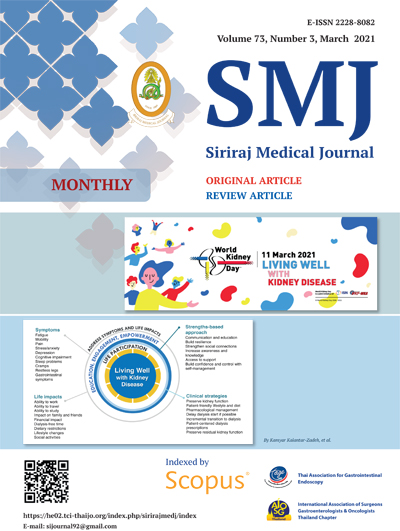Comparison of the Outcomes between Ultrasound-Guided PCNL in Lateral Position and Open Nephrolithotomy for Patients with Staghorn Renal Stones
DOI:
https://doi.org/10.33192/Smj.2021.25Keywords:
staghorn renal stone, ultrasound-guided percutaneous nephrolithotomy, anatrophic nephrolithotomy, lateral positionAbstract
Objective: To compare the clinical outcomes of ultrasound-guided percutaneous nephrolithotomy (US-PCNL) in lateral position and anatrophic nephrolithotomy (ANL) in the treatment of staghorn renal stones.
Methods: This study includes individuals with staghorn renal stones who had an operation at Buri Ram Hospital in Thailand between October 2016 and July 2020. They were divided into two groups; group I includes patients undergoing US-PCNL (n= 114) and group II includes patients undergoing ANL (n=112). The outcomes regarding stone-free rates, the stone clearance rate, operative times, length of hospitalization, and complications were collected and analyzed.
Results: The patient’s demographics and stone characteristics were not significantly different between the two groups, except that the ANL group had more preoperative hydronephrosis (78.6% vs. 53.5%, p < 0.001). Regarding the primary outcome, the stone-free rate was significantly lower in the US-PCNL group (47.4% vs. 75.9%, p < 0.001), whereas the stone clearance rate was not significantly different (96.4±6.0% in the US-PCNL group and 97.7±5.8% in the ANL group, p = 0.098). The major and minor complications between the two groups were not significantly different; however, the US-PCNL group had a significantly lower transfusion rate than the ANL group (3.5% vs. 17.9%, p < 0.001). The total operative time in both groups was not different; however, the length of stay at hospital for the US-PCNL was significantly shorter than for the ANL group (10.0 vs. 12.9 days, p = 0.002).
Conclusion: The ANL had a higher stone-free rate; however, the stone clearance rate was not significantly different between the US-PCNL and ANL groups. There were many advantages of the US-PCNL over the ANL, such as less blood transfusion, shorter length of hospitalization, and no radiation exposure for the patients or the medical personnel, while the complications were not different between the two groups.
References
2. Lojanapiwat B. The ideal puncture approach for PCNL: Fluoroscopy, ultrasound or endoscopy? Indian J Urol IJU J Urol Soc India. 2013;29(3):208–13.
3. Baralo B, Samson P, Hoenig D, Smith A. Percutaneous kidney stone surgery and radiation exposure: A review. Asian J Urol. 2020 Jan;7(1):10–7.
4. Usawachintachit M, Tzou DT, Hu W, Li J, Chi T. X-ray–free Ultrasound-guided Percutaneous Nephrolithotomy: How to Select the Right Patient? Urology. 2017 Feb;100:38–44.
5. Chu C, Masic S, Usawachintachit M, Hu W, Yang W, Stoller M, et al. Ultrasound-Guided Renal Access for Percutaneous Nephrolithotomy: A Description of Three Novel Ultrasound-Guided Needle Techniques. J Endourol. 2016 Feb 1;30(2):153–8.
6. Liu Q, Zhou L, Cai X, Jin T, Wang K. Fluoroscopy versus ultrasound for image guidance during percutaneous nephrolithotomy: a systematic review and meta-analysis. Urolithiasis. 2017 Oct;45(5):481–7.
7. Ng FC, Yam WL, Lim TYB, Teo JK, Ng KK, Lim SK. Ultrasound-guided percutaneous nephrolithotomy: Advantages and limitations. Investig Clin Urol. 2017 Sep;58(5):346–52.
8. Lertkachatarn S. Percutaneous nephrolithotomy (PCNL) : Ultrasound guided puncture. J Prapokklao Hosp Clin Med Educ Cent. 2005;22(4):189–96.
9. Zhang FB-Y, Lin W-R, Yang S, Hsu J-M, Chang H-K, Chen M, et al. Outcomes of percutaneous nephrolithotomy versus open stone surgery for patients with staghorn calculi. Urol Sci. 2017 Jun 1;28(2):97–100.
10. Chen Y, Feng J, Duan H, Yue Y, Zhang C, Deng T, et al. Percutaneous nephrolithotomy versus open surgery for surgical treatment of patients with staghorn stones: A systematic review and meta-analysis. PLOS ONE. 2019;14(1):e0206810.
11. Lingeman JE, Coury TA, Newman DM, Kahnoski RJ, Mertz JH, Mosbaugh PG, et al. Comparison of results and morbidity of percutaneous nephrostolithotomy and extracorporeal shock wave lithotripsy. J Urol. 1987 Sep;138(3):485–90.
12. Clavien PA, Barkun J, de Oliveira ML, Vauthey JN, Dindo D, Schulick RD, et al. The Clavien-Dindo Classification of Surgical Complications: Five-Year Experience. Ann Surg. 2009 Aug;250(2):187–196.
13. Klein I, Gutiérrez-Aceves J. Preoperative imaging in staghorn calculi, planning and decision making in management of staghorn calculi. Asian J Urol. 2020 Apr;7(2):87–93.
14. El-Husseiny T, Buchholz N. The role of open stone surgery. Arab J Urol. 2012 Sep;10(3):284–8.
15. Beiko D, Razvi H, Bhojani N, Bjazevic J, Bayne DB, Tzou DT, et al. Techniques – Ultrasound-guided percutaneous nephrolithotomy: How we do it. Can Urol Assoc J. 2020 Mar;14(3):E104–10.
16. Nualyong C, Sathidmangkang S, Woranisarakul V, Taweemonkongsap T, Chotikawanich E. Comparison of the outcomes for retrograde intrarenal surgery (RIRS) and percutaneous nephrolithotomy (PCNL) in the treatment of renal stones more than 2 centimeters. Thai J Urol. 2019 Jun 2;40(1):9–14.
17. Pitujaturont K, Choonhaklai V. Early experience of supine PCNL in Rajavithi Hospital. Thai J Urol. 2014 Dec 1;35(2):1–11.
18. Merigot de Treigny O, Bou Nasr E, Almont T, Tack I, Rischmann P, Soulié M, et al. The Cumulated Stone Diameter: A Limited Tool for Stone Burden Estimation. Urology. 2015 Sep;86(3):477–81.
19. Winoker JS, Chandhoke RA, Atallah W, Gupta M. Morphometry scores: Clinical implications in the management of staghorn calculi. Asian J Urol. 2020 Apr;7(2):78–86.
20. Cabrera F, Preminger GM, Lipkin ME. As low as reasonably achievable: Methods for reducing radiation exposure during the management of renal and ureteral stones. Indian J Urol IJU J Urol Soc India. 2014;30(1):55–9.
Downloads
Published
How to Cite
Issue
Section
License
Authors who publish with this journal agree to the following conditions:
Copyright Transfer
In submitting a manuscript, the authors acknowledge that the work will become the copyrighted property of Siriraj Medical Journal upon publication.
License
Articles are licensed under a Creative Commons Attribution-NonCommercial-NoDerivatives 4.0 International License (CC BY-NC-ND 4.0). This license allows for the sharing of the work for non-commercial purposes with proper attribution to the authors and the journal. However, it does not permit modifications or the creation of derivative works.
Sharing and Access
Authors are encouraged to share their article on their personal or institutional websites and through other non-commercial platforms. Doing so can increase readership and citations.















